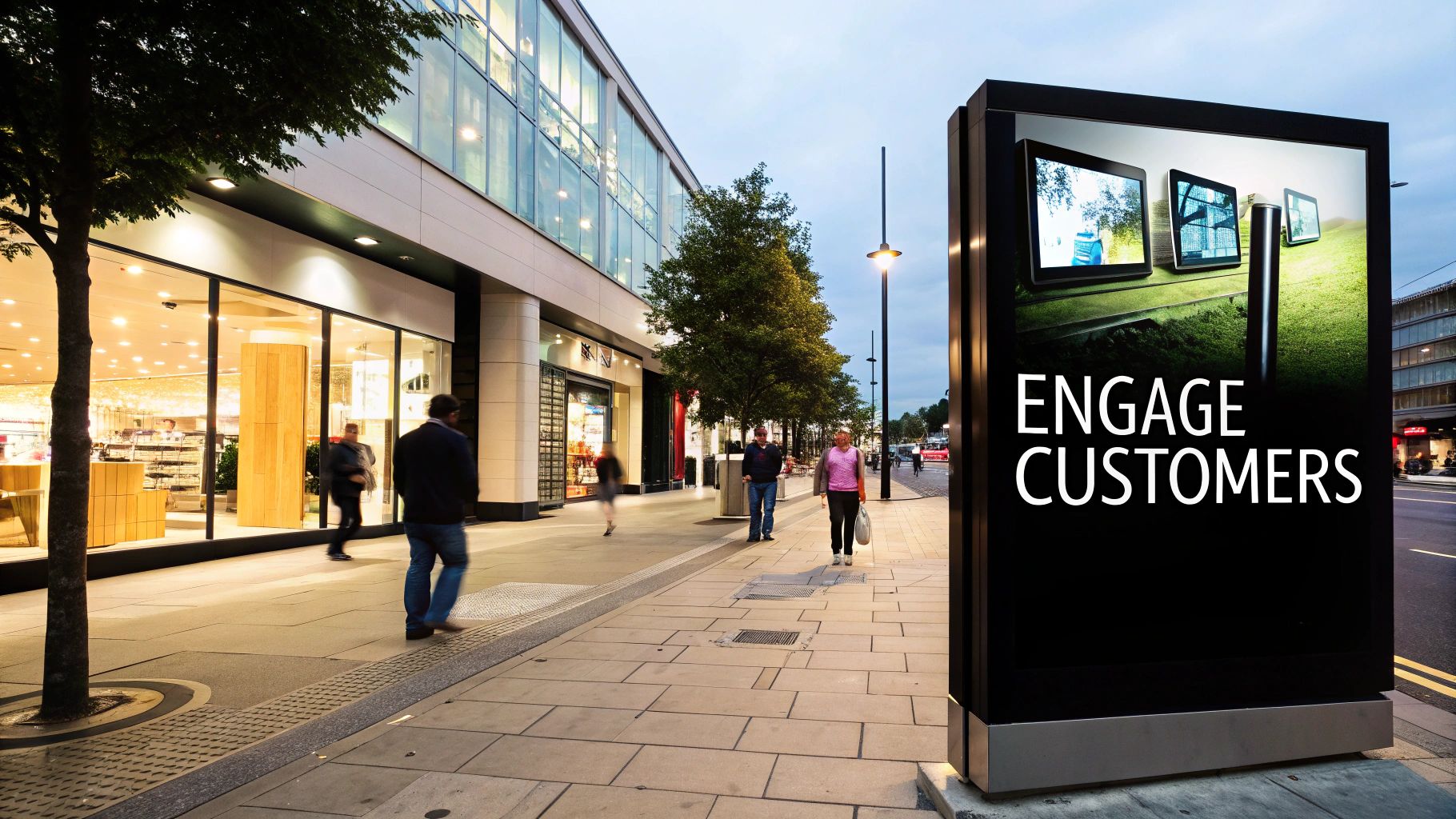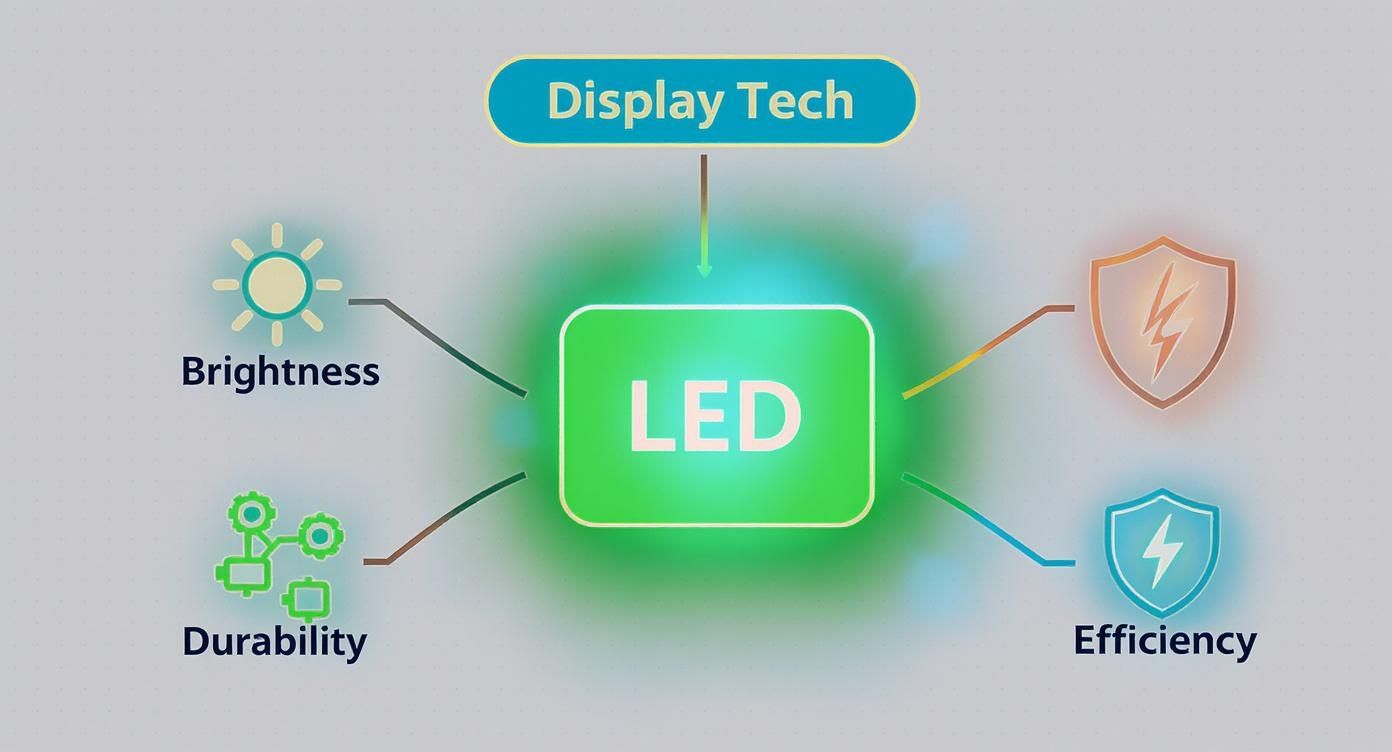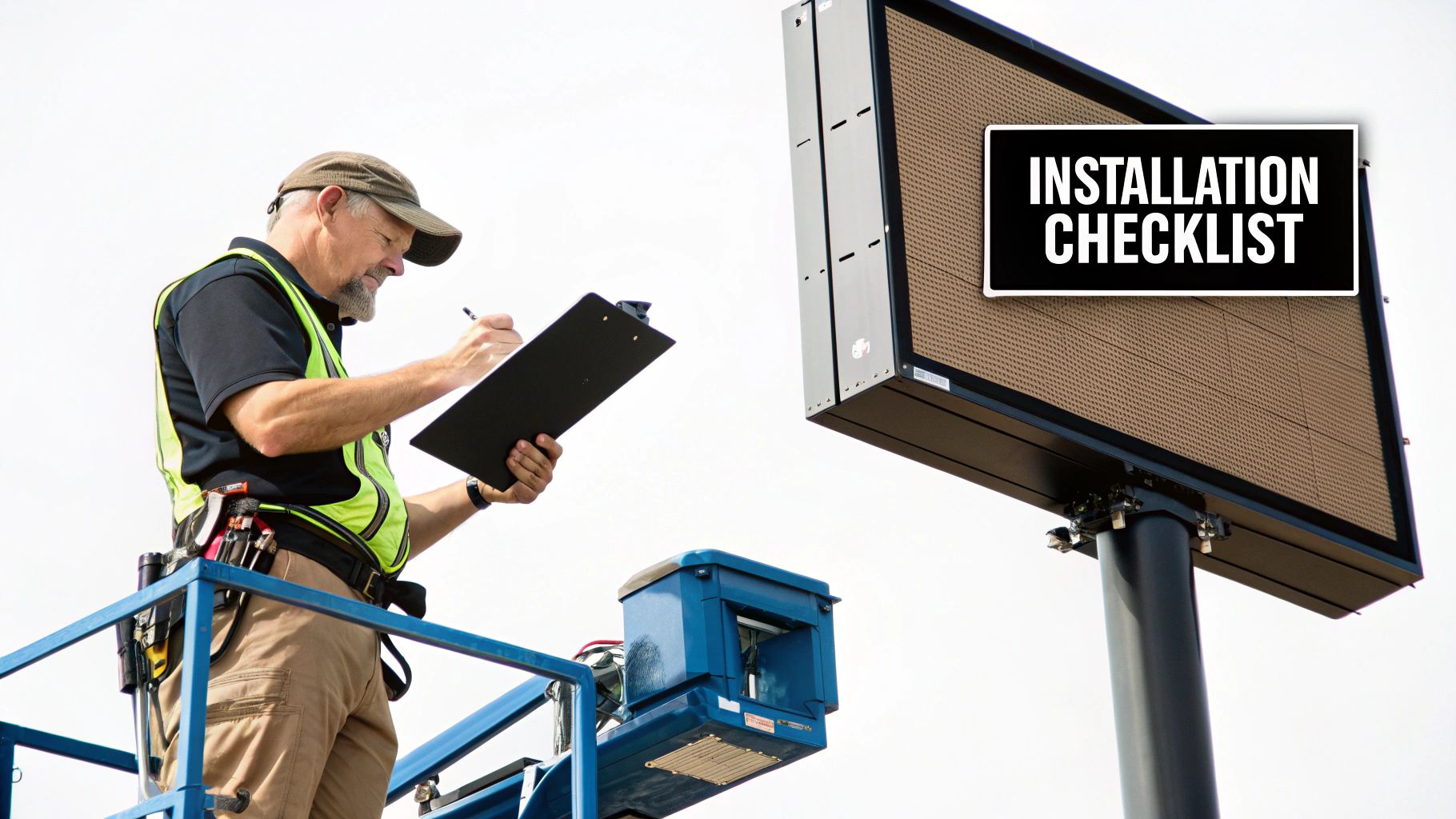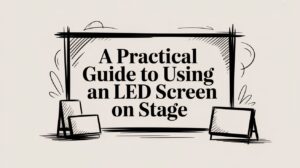
Led Light Wall Panels: led light wall panels Guide to Transform Your Space
Think about the walls around you. For most of history, they’ve been static, passive surfaces. But what if a wall could come alive? What if

Ever seen a storefront sign that does more than just sit there? Imagine it transforming from a static poster into a dynamic, engaging storyteller. That’s the real power of digital outdoor signage. This isn’t just about swapping out printed materials; it’s about starting an active, immediate conversation with your audience.
Think of a traditional sign as a silent billboard. It delivers one message, day in and day out, hoping someone notices. Digital outdoor signage, on the other hand, learns to speak. It’s a complete communication platform that combines a brilliant LED display, a smart media player, and intuitive software to grab attention in ways static signs just can’t compete with.
This isn’t just an upgrade—it’s a fundamental shift in how businesses talk to the world outside their doors. The secret sauce is its ability to be dynamic. Instead of being locked into a single message for weeks or months, you can change your content in a heartbeat. The possibilities for timely, relevant communication are suddenly endless.
The true advantage here is adaptability. Digital displays give businesses the power to react to what’s happening right now, both in their environment and with their customers.
This kind of responsiveness makes your messaging hit so much harder. And the market is noticing—projections show the global digital signage market is on track to hit nearly $46 billion by 2030. That’s a loud and clear signal of just how crucial this technology is becoming for modern advertising.

A digital sign turns a passive glance from a passerby into an active moment of engagement. It’s the difference between a monologue and a conversation starter, giving your brand a voice that can adapt to any situation, time of day, or marketing goal.
Digital outdoor signage is a vital piece of the puzzle within broader digital marketing services, making it possible to run dynamic campaigns that truly capture attention. By integrating these vibrant displays, businesses transform their physical locations into powerful communication hubs, making sure their message is not only seen but remembered.
Picking the right technology for your outdoor sign is a lot like choosing an engine for a vehicle that has to perform in a blizzard one day and a heatwave the next. Reliability and raw power are non-negotiable. While a few different display types exist, the world of digital outdoor signage is completely dominated by one clear winner, and for good reason: LED (Light Emitting Diode) technology. This isn’t just a popular trend; it’s a practical choice that comes down to superior performance where it counts the most.
Ever tried to see your smartphone screen in bright, direct sunlight? More often than not, it looks washed out and is almost impossible to read. That’s the exact battle outdoor digital displays fight every single day. LED technology solves this problem because it’s fundamentally different from other screens, like the LCDs in most TVs and monitors.
Instead of using a big backlight to shine light through pixels from behind, an LED display is made of thousands of tiny, individual diodes that create their own light. Each one is its own light source. This allows the screen to produce incredibly bright, vibrant images that slice right through the harshest glare. This direct light emission is exactly why LED signs stay vivid and impactful, even on the sunniest of afternoons.
When you put a screen outside, it isn’t just fighting the sun. It’s facing down rain, extreme temperatures, and the constant demand for 24/7 operation. This is where the built-in strengths of LED displays make them the only real choice for any serious digital outdoor signage project.
Here are the core reasons why LED stands head and shoulders above the rest:
To put it in black and white, let’s look at how these two technologies stack up against each other.
When you’re looking at specs, it’s easy to get lost in the numbers. But for outdoor use, the differences are night and day. This table breaks down what really matters when a display has to live outside.
| Feature | LED Displays | LCD Displays |
|---|---|---|
| Brightness | Very high; easily visible in direct sunlight. | Moderate; struggles with glare and can look washed out. |
| Outdoor Durability | Excellent; designed to resist weather, moisture, and impact. | Poor; requires bulky, expensive enclosures for protection. |
| Lifespan | Long; typically 100,000 hours or more of operation. | Shorter; backlights can dim and fail over time. |
| Energy Use | More efficient, leading to lower long-term operating costs. | Higher consumption, especially for outdoor-rated models. |
As you can see, the contest isn’t even close. For the demands of an outdoor environment, LED is the only technology that checks all the boxes without compromises.
So, why not just stick a big TV outside and call it a day? Consumer-grade LCD screens, like the one in your living room, just aren’t built for the abuse. They don’t have the brightness to compete with the sun and are incredibly vulnerable to damage from moisture and temperature swings. While some commercial-grade LCDs exist in heavy protective enclosures, they often end up being bulky, less efficient, and far more expensive for what they deliver.
LED technology isn’t just a better option; it’s the purpose-built solution. It was engineered from the ground up to conquer the unique environmental and visibility challenges that outdoor digital signage presents, ensuring your message is always delivered with clarity and impact.
Choosing LED is an investment in visibility, reliability, and peace of mind. The technology continues to push boundaries, and you can see the latest advancements with the introduction of the Outdoor Elite Series 3mm fully sealed waterproof panel line from Smart LED Inc. This relentless focus on durability ensures your digital outdoor signage remains a powerful communication tool for years to come, no matter what mother nature throws at it.
Reading a spec sheet for an outdoor digital sign can feel like trying to translate a foreign language. You’re hit with a wall of acronyms and numbers that can feel overwhelming, but don’t worry. Understanding a few core metrics is all it takes to make a smart investment. Think of this section as your practical translator, breaking down the three most critical specs you need to confidently evaluate any outdoor sign.
These three pillars—brightness, pixel pitch, and IP rating—are what really matter. They dictate how your sign looks, how well it performs from different distances, and how long it’s going to survive out in the elements. Getting them right is the key to ensuring your message is seen clearly and your hardware lasts for years.
The single most important job of any outdoor digital sign is to stay visible in direct sunlight. This is where brightness, measured in a unit called nits, comes into play. A high nit rating is like a great pair of polarized sunglasses for your sign—it cuts through the harshest glare to keep your content looking sharp and vibrant.
Your indoor TV probably clocks in around 300 to 500 nits. That looks fantastic in your living room, but outside it would be a washed-out, unreadable gray rectangle. For a sign to work well even in a shaded outdoor spot, you need at least 2,500 nits. For any location that gets hit with direct sunlight, you should be looking for displays rated at 5,000 nits or higher. That’s the kind of power you need to make sure your message always pops.
This infographic breaks down the essential performance pillars of modern LED display technology.

As you can see, brightness, durability, and efficiency are all interconnected parts that define a high-quality outdoor LED sign.
Once you know your sign will be bright enough, the next question is: how clear will the image be? This is all about pixel pitch, which is just the distance in millimeters from the center of one pixel to the center of the next one. A smaller pixel pitch number simply means the pixels are packed tighter together, which creates a higher-resolution image.
Think of it just like the resolution of a photograph.
There’s a handy rule of thumb: for every 1mm of pixel pitch, add about 8 feet of optimal viewing distance. So, a sign with a 10mm pixel pitch is going to look its best from 80 feet away or more. Matching the pixel pitch to where your audience will be is the secret to a professional-looking message.
Finally, your outdoor sign has to be tough enough to handle whatever nature throws at it. That’s where the IP Rating (or Ingress Protection Rating) comes in. It’s a simple, standardized two-digit score that tells you exactly how well the sign’s casing is sealed against solids (like dust) and liquids (like rain).
Each of the two numbers tells a different story:
A very common and reliable rating for outdoor signs is IP65. This tells you the sign is totally sealed against dust (the “6”) and can handle low-pressure water jets from any angle (the “5”), making it more than ready for heavy rainstorms. Understanding this score gives you real peace of mind that your investment is built to last.
Understanding the specs of an outdoor digital sign is one thing, but the real magic happens when you put that technology into motion. A digital sign is so much more than just hardware; it’s a living, breathing tool for growth, capable of changing its message to fit the exact needs of the moment. This is where theory meets the real world, turning a bright screen into a powerful engine for engagement and sales.
Think about a retail store running a flash sale. With a static sign, they might pull in a few curious shoppers. With a digital display, they can crank up the urgency with a live countdown timer, then switch the promotion from 50% off to 60% off in the final hour to drive a last-minute rush. That kind of real-time agility is just impossible with print.
The truth is, digital outdoor signage has found a home in nearly every industry, with businesses using the tech to solve unique challenges and create better customer experiences.
Let’s get out of the abstract and look at how real businesses are using these displays every single day to hit their goals. Each of these scenarios shows just how adaptable this technology is.
These examples make it clear: a sign’s value isn’t just in what it is, but in what it does. It becomes a living, functional part of a business’s daily operations.
This incredible versatility has fueled a massive boom in the digital out-of-home (DOOH) advertising market. Businesses aren’t just advertising their own stuff anymore; they’re becoming part of a larger, interconnected ad ecosystem.
And the numbers back it up. The global digital signage market is expected to rocket from $29.22 billion in 2024 to $57.78 billion by 2033. This explosion is powered by tech like 5G that makes real-time, programmatic ad delivery possible. You can dive deeper into this incredible market growth over at Fortune Business Insights.
A digital sign transforms your physical location from a passive storefront into an active media channel. You gain the power to inform, entertain, and persuade your audience with content that is always relevant, timely, and visually striking.
Once your sign is up and running, the next crucial piece is managing what it shows. This isn’t just about static images, but also dynamic content like news, weather, and social media feeds. True success comes from effectively managing content feeds for your digital signage to keep your messaging fresh and your audience hooked. The goal is to create a seamless flow of information that grabs attention and delivers real results, turning your initial investment into a long-term asset that keeps driving value.
Making the leap to digital outdoor signage is a big move, and to do it right, you need to understand the full financial picture. It’s tempting to get fixated on the price tag of the screen, but the true cost is much more than just the hardware. We need to look at the Total Cost of Ownership (TCO).
This just means thinking about every cost that comes up over the entire life of your sign. Getting these numbers straight from the beginning saves you from nasty budget surprises down the road and helps you plan for a long-term asset, not just a one-off purchase.
To get your budget right, you need to think beyond the initial check you write for the sign itself. Here are the other key pieces of the puzzle:
Okay, so you know what it’s going to cost. Now for the fun part: proving its value. This is where you calculate your Return on Investment (ROI) and shift the conversation from “expense” to “money-making machine.” This is how you build a rock-solid case for investing in a digital sign.
The good news? You’re not alone. The outdoor signage market is exploding, proving just how effective these signs are. The market was valued at around $32.1 billion in 2025 and is on track to more than double to a staggering $69.8 billion by 2035. That kind of growth only happens when businesses see real, measurable results. You can learn more about the expanding outdoor signage market.
The whole idea behind ROI is simple: Is the new value you’re creating with the sign more than what you paid for it? That “value” can be anything from a spike in sales to entirely new revenue streams.
Let’s look at how this plays out in the real world. A classic way to measure this is by tracking the sales lift for a specific product you advertise. If you promote a daily lunch special on the sign and see a 25% jump in sales for that item every time it’s up there, that’s a direct return you can take to the bank.
Another game-changing strategy is to sell ad space to other local, non-competing businesses. Suddenly, your sign isn’t just an advertising tool—it’s a new source of income that helps pay for itself. Our complete guide walks you through more of these strategies and explains how to buy an LED sign with these considerations in mind.
To make it even clearer, here’s a sample calculation showing how a business might track its ROI over a year.
| Metric | Calculation/Example Data | Result |
|---|---|---|
| Total Sign Investment (TCO) | Hardware, Install, Permits, Software (Year 1) | $30,000 |
| Increased Sales from Promotions | $1,500/month x 12 months | $18,000 |
| Revenue from Selling Ad Space | 2 advertisers @ $500/month each x 12 months | $12,000 |
| Total Revenue Generated | $18,000 (Sales) + $12,000 (Ads) | $30,000 |
| Net Profit (Year 1) | $30,000 (Revenue) – $30,000 (TCO) | $0 |
| Return on Investment (ROI) | (Net Profit / Total Investment) x 100 | 0% |
In this simple example, the sign completely paid for itself in the first year alone! From year two onward, with the initial investment covered, that $30,000 in annual revenue (or more!) becomes pure profit. By tracking these kinds of numbers, you can stop guessing and start proving the incredible financial power of your digital sign.

Getting a high-performance digital outdoor sign is a fantastic investment, but its real, long-term success comes down to more than just its tech specs. Proper installation and consistent care are what truly protect your asset. They ensure it performs flawlessly day in and day out, delivering value for years to come.
Think of it like building a house—you wouldn’t just start digging without a solid blueprint and the right permits. The same exact principle applies here. Before you even finalize a purchase, the very first step is to get familiar with your local zoning laws and regulations. Every city has different rules about sign size, brightness, and placement, so getting this sorted out upfront is non-negotiable.
This initial planning phase is where the magic happens. Rushing through it is a recipe for costly delays or, even worse, fines down the road. It’s all about doing your homework to lay a solid foundation for the entire project.
Here’s a simple checklist to get you started:
A successful installation is 90% planning and 10% execution. Taking the time to sort out permits, site readiness, and structural needs beforehand prevents the most common and expensive installation headaches.
Once your digital sign is installed and shining brightly, the job isn’t quite done. A proactive maintenance routine is what will maximize its lifespan, which can often be 10 to 15 years or even more. A little bit of regular care keeps it looking great and running like a dream.
This doesn’t have to be complicated. Simple, consistent checks can stop small issues from snowballing into major problems. For a more streamlined approach, you might want to consider ready-to-install solutions, like the ones we detail in our guide to outdoor LED sign kits, which can simplify both the setup and ongoing care.
Here is a straightforward maintenance checklist to follow:
Jumping into the world of digital outdoor signage can feel like a big step, and naturally, you’ve probably got some questions. We hear them all the time from business owners just like you. Let’s clear up some of the most common ones so you can move forward with total confidence.
This is usually the first thing people ask, and for good reason—it’s an investment. The good news is that a quality outdoor LED sign is built like a tank. You can expect a high-performance display to run for up to 100,000 hours.
What does that mean in the real world? With the right care, you’re looking at a lifespan of 10 to 15 years. A little bit of routine maintenance, like keeping the screen clean and doing occasional hardware checks, goes a long way in making sure your message stays bright and impactful for a decade or more.
We get it. It seems like a clever way to save a few bucks, but putting a regular indoor TV outside is a recipe for disaster. It’s just not cut out for the job. There are two huge dealbreakers:
A purpose-built outdoor display is engineered from the ground up with robust weatherproofing (that’s what the IP rating is for) and ultra-high brightness to not just survive, but thrive outside.
Using a regular TV outdoors is like taking a family sedan to an off-road race—it simply wasn’t designed for the environment and won’t last long. Investing in a true outdoor-rated display is essential for reliability and performance.
Absolutely. In fact, it’s one of the most powerful marketing tools a local business can have. A digital sign delivers a tangible return by directly influencing what customers do right at your doorstep. Here’s how it boosts your bottom line:
For most businesses, the sign pays for itself within the first couple of years through a bump in sales and massively increased visibility. Think of it as your best salesperson, working 24/7.
Ready to see how digital outdoor signage can transform your business? The experts at Smart LED Inc. are here to help you find the perfect high-impact visual solution. Explore our factory-direct outdoor LED signs today!

Think about the walls around you. For most of history, they’ve been static, passive surfaces. But what if a wall could come alive? What if

Walk into just about any major production today, and you’ll see it: a brilliant, larger-than-life LED screen on stage commanding attention. It’s no longer just

Imagine taking a regular poster and turning it into something impossible to ignore—a vibrant, glowing display that seems to light up from within. That’s the
"*" indicates required fields